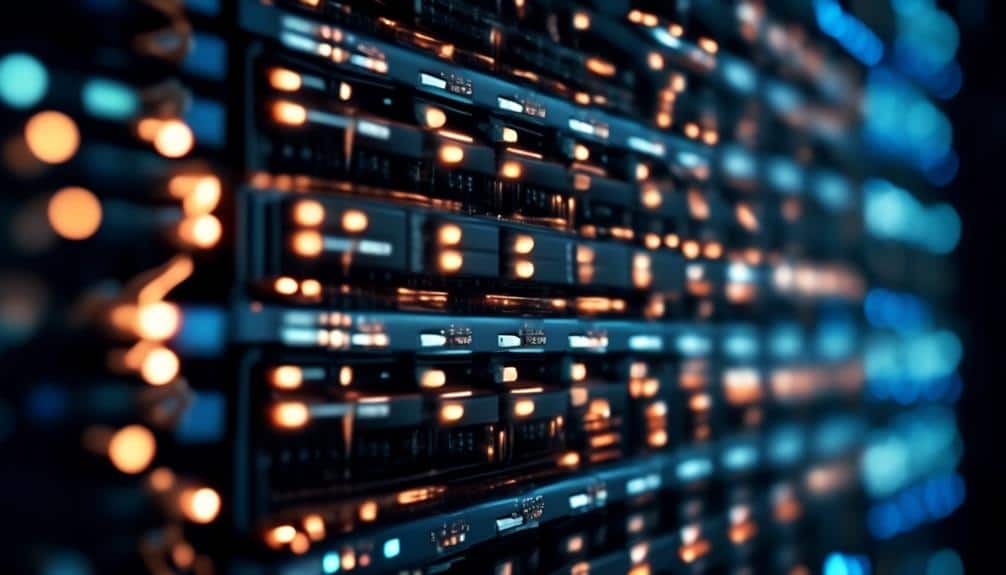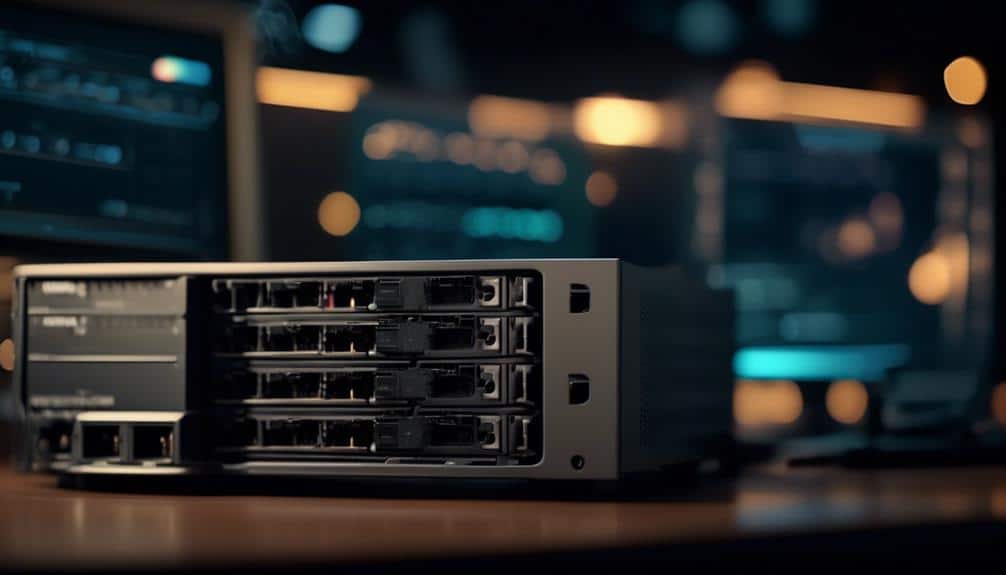Quick Guide: Implementing Effective Caching for Seamless User Experiences
Imagine you're on a busy highway, rushing to reach your destination. Suddenly, you encounter an unexpected roadblock, bringing your journey to a halt. Frustrating, isn't it?
Just like this scenario, slow loading times and lagging applications can create a similar roadblock for users, hindering their digital experience. But fear not! In this quick guide, we will explore the world of effective caching and how it can pave the way for seamless user experiences.
So buckle up and get ready to unlock the secrets of optimizing performance, improving responsiveness, and ensuring a smooth ride for your users.
Key Takeaways
- Caching improves performance and efficiency of software applications by storing frequently accessed data in a temporary storage location.
- There are different types of caching techniques such as time-based caching, LRU caching, in-memory cache, and content delivery networks (CDNs).
- Evaluating caching needs is important to optimize caching strategies and identify caching opportunities.
- Implementing caching techniques involves evaluating data for caching, studying user behavior, determining cache invalidation and expiration strategies, and optimizing cache performance.
What Is Caching and Why Is It Important?

Caching is a crucial mechanism that improves the performance and efficiency of software applications by storing frequently accessed data in a temporary storage location. By doing so, it reduces the need to fetch data from the original source repeatedly, resulting in faster response times and improved user experiences.
One of the key benefits of caching is that it reduces the load on the application's backend systems. By storing frequently accessed data in a cache, the application can retrieve it more quickly, without the need to make expensive database or network calls. This not only improves the overall performance of the application but also reduces the strain on the backend infrastructure.
There are several caching techniques that can be employed to maximize the benefits of caching. These techniques include using an in-memory cache, such as Redis or Memcached, to store data in RAM for faster access times. Another technique is to use content delivery networks (CDNs) to cache static content, such as images or CSS files, closer to the end users, reducing latency and improving load times.
Understanding the Different Types of Caching
Now that you have a clear understanding of the importance and benefits of caching, let's explore the different types of caching available.
When it comes to caching algorithms, there are two main types: Time-based caching and Least Recently Used (LRU) caching.
Time-based caching involves setting an expiration time for cached data. This means that once the expiration time is reached, the cache is invalidated and new data is fetched from the source. This method is particularly useful for data that doesn't change frequently and can be safely cached for a specific duration.
On the other hand, LRU caching is based on the principle that the least recently used data is the most likely to be replaced. In this method, a fixed amount of memory is allocated for the cache, and when the cache is full, the least recently used data is evicted to make room for new data.
In addition to caching algorithms, cache invalidation methods are crucial for maintaining data consistency. Some common cache invalidation methods include time-based invalidation, where the cache is invalidated after a specific time interval, and event-based invalidation, where the cache is invalidated when a specific event occurs.
Understanding the different types of caching and cache invalidation methods is essential for implementing an effective caching strategy that ensures seamless user experiences.
Evaluating Your Website or App's Caching Needs

To effectively implement caching for your website or app, it's crucial to evaluate your caching needs.
This involves understanding the importance of caching in improving performance and reducing server load.
Importance of Caching
Evaluate your website or app's caching needs to ensure optimal performance. Caching plays a crucial role in improving user experiences by reducing load times and minimizing server requests. To fully grasp the importance of caching, consider the following:
- Evaluating caching benefits:
Caching helps improve website or app performance by storing frequently accessed data, such as images or CSS files, locally on the user's device. This reduces the need for repeated server requests, resulting in faster load times and a smoother user experience.
- Measuring caching effectiveness:
It's essential to regularly monitor and analyze the impact of caching on your website or app. Track metrics such as page load times, server response times, and the number of cache hits to evaluate the effectiveness of your caching strategy.
- Optimizing caching strategies:
To maximize caching benefits, consider implementing strategies like setting appropriate cache expiration times, utilizing cache invalidation techniques, and leveraging browser caching to store static resources.
Identifying Caching Opportunities
To effectively identify caching opportunities, carefully analyze your website or app's caching needs. Start by conducting an opportunities analysis to identify areas where caching can bring the most benefits. Consider the types of content or data that are frequently accessed or updated. Are there any pages or features that require complex processing or database queries? These are potential candidates for caching.
Additionally, evaluate user behavior patterns to identify common navigation paths or frequently accessed resources. This will help you determine which elements should be cached to improve performance.
Once you have identified the caching opportunities, you can proceed with implementing caching implementation strategies such as page caching, object caching, or database query caching.
Optimizing Cache Performance
Now, in order to optimize cache performance, thoroughly assess your website or app's caching needs by analyzing data usage, user behavior, and potential candidates for caching. To help you with this process, consider the following:
- Data Usage: Evaluate which data is frequently accessed and updated. This will help determine what data should be cached to improve performance.
- User Behavior: Study how users interact with your website or app. Identify common user actions and pages that are frequently visited. By understanding user behavior patterns, you can prioritize caching efforts accordingly.
- Cache Invalidation and Expiration: Determine the appropriate cache invalidation and expiration strategies for your application. This ensures that cached data is consistently up to date and avoids presenting users with outdated information.
Implementing Server-Side Caching Techniques

Consider using server-side caching techniques to improve the performance and efficiency of your application.
Server-side caching implementation refers to caching data directly on the server, reducing the need to fetch it from the database or generate it on the fly. This can significantly improve response times, decrease server load, and enhance the overall user experience.
To implement server-side caching, you can utilize various caching techniques for improved performance.
One common approach is to use a caching layer like Redis or Memcached. These in-memory data stores allow you to store frequently accessed data in memory, enabling faster retrieval and reducing the load on the database.
Another technique is to implement HTTP caching headers. By setting appropriate cache-control headers, you can instruct the client's browser to cache certain resources, such as static files or API responses, locally. This reduces the number of requests sent to the server, resulting in faster page loads and improved performance.
Additionally, you can implement object caching, where you cache the result of computationally expensive operations or complex queries. By storing the result in memory or a distributed cache, you can avoid repeating the same calculations or database queries, leading to significant performance gains.
Leveraging Browser Caching for Improved Performance
Improve the performance of your application by leveraging browser caching for faster page loads and enhanced user experience.
Browser caching allows web browsers to store static files, such as images, stylesheets, and JavaScript files, locally on a user's device. By doing so, subsequent visits to your website will be faster as the browser can fetch these files from the local cache instead of making a request to the server.
Here are three reasons why leveraging browser caching is crucial for improving page load times and reducing server load:
- Faster page loads: By caching static resources, such as images and stylesheets, the browser can quickly retrieve them from the local cache. This eliminates the need for repeated server requests, resulting in significantly faster page load times for your users.
- Reduced server load: Caching static files on the client-side reduces the number of requests your server needs to handle, leading to a reduced server load. This can free up server resources to handle other requests, improving the overall performance and scalability of your application.
- Enhanced user experience: Faster page load times contribute to a better user experience. When your website loads quickly, users are more likely to stay engaged and explore further. Additionally, reduced server load ensures that your application can handle traffic spikes without slowing down or experiencing downtime.
Utilizing Content Delivery Networks (Cdns) for Efficient Caching

To improve caching efficiency, consider utilizing Content Delivery Networks (CDNs). CDNs offer several benefits, including speeding up content delivery and enhancing user experience.
CDN Benefits for Caching
Utilize Content Delivery Networks (CDNs) to enhance caching efficiency and improve user experience. CDNs offer several benefits that can significantly improve website performance:
- Reduced latency: CDNs have multiple servers located in different geographic regions. By caching your website's content on these servers, CDNs ensure that users can access your content from a server that's physically close to them. This reduces the distance data has to travel, resulting in faster load times and lower latency.
- Improved scalability: CDNs distribute the load across multiple servers, allowing them to handle high volumes of traffic without impacting performance. This ensures that your website remains responsive even during peak usage periods.
- Enhanced reliability: CDNs employ advanced caching techniques and robust infrastructure to ensure that your content is always available. By reducing the load on your origin server, CDNs also help prevent server crashes and downtime.
Speeding Up Content Delivery
Consider leveraging Content Delivery Networks (CDNs) to optimize caching and accelerate content delivery for improved website performance.
CDNs are distributed systems that store cached content in multiple data centers across the globe. By utilizing CDNs, you can reduce latency and deliver content to your users faster, regardless of their location.
CDNs work by caching your website's static content, such as images, videos, and JavaScript files, in their edge servers. When a user requests content from your website, the CDN serves the cached content from the nearest edge server, reducing the time it takes for the content to reach the user's device. This not only speeds up content delivery but also improves the overall user experience.
Furthermore, CDNs can also be used to deliver personalized content based on user preferences, ensuring a tailored experience for each user.
Enhancing User Experience
Improve user experience by leveraging Content Delivery Networks (CDNs) for efficient caching. CDNs can greatly enhance the performance and speed of your website, providing a seamless browsing experience for your users.
Here are three ways CDNs can enhance user experience:
- Faster content delivery: CDNs distribute your content across multiple servers located in various geographical locations. This helps reduce latency and ensures that your users receive your content from the server closest to their location, resulting in faster loading times.
- Improved reliability: CDNs help distribute the load on your servers, reducing the risk of downtime and improving overall website reliability. This ensures that your users can access your website without any interruptions.
- Enhanced personalization techniques: CDNs can also be used to implement personalization techniques and user engagement strategies. By caching personalized content, such as user preferences or recommendations, CDNs can deliver a more tailored experience to your users.
Caching Strategies for Dynamic Content

To optimize the performance of your dynamic content, employing effective caching strategies is essential. Caching plays a crucial role in improving the speed and responsiveness of your website or application.
When it comes to caching strategies for e-commerce websites and database-driven applications, there are a few techniques you can implement to ensure seamless user experiences.
One common approach is to implement page-level caching. This involves caching the entire HTML output of a dynamically generated page. By doing so, subsequent requests for the same page can be served directly from the cache, reducing the load on your server and improving response times. However, it's important to consider the cache invalidation mechanism to ensure that the cached content is refreshed when necessary.
Another strategy is partial caching, where only specific sections of a page are cached. This allows for more granular control over what content is cached, ensuring that dynamic elements are still updated while static sections can be served from the cache.
In addition, caching database queries can significantly improve performance. By storing the results of frequently executed queries in a cache, subsequent requests can be served directly from the cache, eliminating the need for redundant database access.
It's worth noting that implementing an effective caching strategy requires careful consideration of your specific application's requirements and architecture. Therefore, it's recommended to thoroughly analyze your application's usage patterns and consult with caching experts to determine the most suitable caching techniques for your dynamic content.
Monitoring and Optimizing Cache Performance
To effectively monitor and optimize cache performance, you need the right tools and techniques.
Cache monitoring tools provide valuable insights into cache usage, hit rates, and efficiency, allowing you to identify bottlenecks and make informed decisions for optimization.
Performance optimization techniques such as cache tuning, eviction policies, and cache warming can further enhance cache performance.
Real-time cache analysis helps you continuously monitor and fine-tune cache settings to ensure optimal performance and responsiveness.
Cache Monitoring Tools
Consider implementing cache monitoring tools to optimize the performance of your cache. Monitoring the effectiveness of your cache is crucial for delivering a seamless user experience.
Here are three cache monitoring techniques that can help you measure cache effectiveness:
- Real-time monitoring: Utilize tools that provide real-time visibility into cache performance, allowing you to identify bottlenecks and optimize cache configuration on the fly.
- Key metrics tracking: Track key performance metrics such as cache hit rate, cache utilization, and response time to gain insights into cache efficiency and identify areas for improvement.
- Alerting and notifications: Implement tools that can alert you when cache performance falls below acceptable thresholds, enabling you to take proactive measures to maintain optimal cache performance.
Performance Optimization Techniques
Optimizing cache performance is essential for delivering a seamless user experience. One effective technique is monitoring and optimizing cache performance. To achieve optimal performance, you need to implement performance tuning strategies and caching techniques.
Performance tuning involves analyzing the cache usage patterns, identifying bottlenecks, and fine-tuning the cache configuration accordingly. It's crucial to monitor cache hit rates, eviction rates, and response times to identify potential performance issues. By regularly monitoring cache performance, you can proactively identify and address any inefficiencies in the caching system.
Additionally, optimizing cache performance requires implementing caching techniques such as cache partitioning, cache invalidation strategies, and cache preloading. These techniques ensure that the cache is efficiently utilized, reducing the load on the backend systems and improving response times.
Real-Time Cache Analysis
When monitoring and optimizing cache performance in real-time, it's crucial to analyze cache usage patterns and identify potential bottlenecks for effective performance tuning.
To ensure seamless user experiences, here are three essential aspects to consider:
- Real-time cache invalidation: Keep track of data changes and update the cache accordingly. By invalidating the cache when necessary, you can ensure that users always receive the most up-to-date information.
- Cache expiration strategies: Determine the appropriate expiration time for cached data based on its volatility. Implementing expiration strategies such as time-based or event-based expiration can help maintain cache freshness and prevent serving stale data to users.
- Continuous monitoring and optimization: Regularly monitor cache performance metrics, such as hit rate and eviction rate, to identify areas for improvement. Optimize cache configurations and eviction policies based on real-time analysis to maximize cache efficiency and minimize performance bottlenecks.
Caching Best Practices for Mobile Applications
To ensure efficient performance and enhance user experience, follow these caching best practices for mobile applications.
One important aspect of caching is cache invalidation. It's crucial to have a mechanism in place that detects when data in the cache becomes outdated or irrelevant. This can be achieved through cache expiration, where a time limit is set for how long the cached data is considered valid. By implementing cache invalidation and cache expiration, you can ensure that users are always presented with the most up-to-date information, without the need to constantly fetch data from the server.
Another best practice is to carefully choose what data to cache. Mobile devices have limited storage and resources, so it's important to only cache data that's frequently accessed or has a significant impact on the user experience. Prioritize caching data that's static or changes infrequently, such as images or configuration files. Additionally, consider implementing cache partitioning, where different types of data are stored in separate caches, to improve performance and avoid cache pollution.
Lastly, regularly monitor and analyze the performance of your caching mechanism. Measure cache hit rate and response times to identify any bottlenecks or areas for improvement. By following these best practices, you can effectively leverage caching in your mobile application to provide seamless and responsive user experiences.
Future Trends and Advancements in Caching Technology

As technology continues to evolve, advancements in caching technology are shaping the future of efficient performance and user experience, building upon the best practices discussed earlier.
Here are three emerging trends and advancements in caching technology that you should be aware of:
- Machine Learning-based Caching: Machine learning algorithms can analyze user behavior and patterns to predict future content requests. By proactively caching frequently accessed data, machine learning-based caching improves response times and reduces network traffic, leading to faster and more seamless user experiences.
- Distributed Caching: With the rise of edge computing, caching is moving closer to the user. Distributed caching allows you to store and serve content from multiple cache servers located at the network edge, reducing latency and improving performance. This is especially beneficial for geographically distributed user bases or applications that rely on real-time data.
- Serverless Caching: Serverless architectures are gaining popularity due to their scalability and cost efficiency. Serverless caching leverages managed caching services provided by cloud providers, eliminating the need for managing cache servers and infrastructure. This allows you to focus on application logic while still benefiting from the performance gains of caching.
These emerging caching technologies, combined with the impact of edge computing, are revolutionizing how data is cached and delivered to users. By staying informed and adopting these advancements, you can ensure that your applications deliver seamless user experiences while maximizing performance and scalability.
Frequently Asked Questions
How Does Caching Affect the Security of My Website or App?
Caching can greatly impact your website's speed and performance. However, when it comes to sensitive data, you need to consider the security risks. Make sure to implement proper measures to protect this information.
Can Caching Be Applied to All Types of Dynamic Content?
Caching limitations and implementation challenges vary for different types of dynamic content. It's important to consider factors like data freshness and cache invalidation when applying caching to ensure seamless user experiences.
Are There Any Drawbacks or Limitations to Implementing Caching Techniques?
There can be drawbacks and limitations when implementing caching techniques. It's important to consider factors such as cache invalidation, storage capacity, and the potential for stale data.
How Can I Measure the Performance and Effectiveness of My Caching Strategy?
To measure caching performance and optimize cache efficiency, you can track metrics like cache hit rate, response time, and throughput. Regularly analyze these metrics to identify areas for improvement and make adjustments to your caching strategy accordingly.
What Are Some Potential Future Advancements in Caching Technology That I Should Be Aware Of?
You should be aware of potential advancements in caching technology such as edge computing and machine learning. These advancements can improve the speed and efficiency of caching, leading to even more seamless user experiences.
Conclusion
In conclusion, implementing effective caching techniques is crucial for delivering seamless user experiences.
By understanding the different types of caching and evaluating your website or app's specific needs, you can optimize performance and reduce load times.
Implementing server-side caching and leveraging browser caching are important steps in improving overall performance.
Monitoring and optimizing cache performance, as well as following best practices for mobile applications, will ensure a smooth user experience.
Stay updated on future trends and advancements in caching technology for continued optimization.








